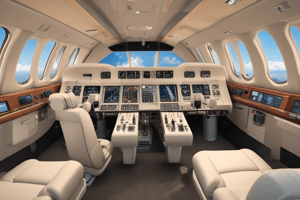Podcast
Questions and Answers
What is the purpose of the Brake-by-Wire system on the aircraft?
What is the purpose of the Brake-by-Wire system on the aircraft?
The Brake-by-Wire system controls the braking of the aircraft. When this system fails, the amber 'Brake By Wire Fail' message is displayed.
How does the aircraft indicate a failure of the left or right wing retrim system?
How does the aircraft indicate a failure of the left or right wing retrim system?
The aircraft indicates a failure of the left or right wing retrim system with the amber 'Retrim Left Wing Down' or 'Retrim Right Wing Down' messages.
What is the significance of the 'L-R Aileron Fail' message?
What is the significance of the 'L-R Aileron Fail' message?
The 'L-R Aileron Fail' message indicates a failure of both remote electronics units or a loss of aileron command to both ailerons. This results in a loss of roll authority.
How does the aircraft indicate that the roll axis flight control surfaces are approaching their maximum displacement?
How does the aircraft indicate that the roll axis flight control surfaces are approaching their maximum displacement?
What is the purpose of the 'Speed Brake Auto Retract' message?
What is the purpose of the 'Speed Brake Auto Retract' message?
Describe the purpose and function of the RVDT sensors in the aircraft's flight control system.
Describe the purpose and function of the RVDT sensors in the aircraft's flight control system.
Explain how the flight control computers (FCCs) and the BFCU use the RVDT sensor data to control the aircraft's flight surfaces.
Explain how the flight control computers (FCCs) and the BFCU use the RVDT sensor data to control the aircraft's flight surfaces.
Describe the redundancy and fault tolerance built into the RVDT sensor system.
Describe the redundancy and fault tolerance built into the RVDT sensor system.
Explain the purpose and function of the Remote Electronic Units (REUs) in the aircraft's flight control system.
Explain the purpose and function of the Remote Electronic Units (REUs) in the aircraft's flight control system.
Describe the role of the flight control computers (FCCs) in the aircraft's flight control system.
Describe the role of the flight control computers (FCCs) in the aircraft's flight control system.
Flashcards are hidden until you start studying




